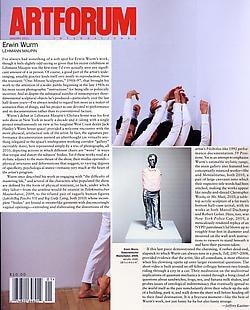
Erwin Wurm Lehmann Maupin
Jeffrey Kastner
I've always had something of a soft spot for Erwin Wurm's work, though it feels slightly odd saying so given that his recent exhibition at Lehmann Maupin was the first time I'd ever actually seen any significant amount of it in person. Of course, a good part of the artist's wideranging, amiable practice lends itself very neatly to reproduction, from the transient "One-Minute Sculptures," 1988-97, that brought his work to the attention of a wider public beginning in the late 1980s to his more recent photographic "instructions" for being idle or politically incorrect. And so despite the substantial number of non temporary three dimensional sculptural objects he's produced-particularly over the last half-dozen years-I've always tended to regard him more as a maker of scenarios than of things, and his project as one devoted to performance and its documentation rather than to conventional facture.
Wurm's debut at Lehmann Maupin's Chelsea home was his first solo show in New York in nearly a decade and it (along with a single project simultaneously on view at his longtime West Coast dealer Jack Hanley's Watts Street space) provided a welcome encounter with the more physical, artifactual side of the artist. In fact, the signature performance documentation seemed an afterthought (as virtually anything relegated to the space's misbegotten working corridor "gallery" inevitably does), here represented simply by a trio of photographs, all 2010, depicting actions in which different chairs are "worn" in ways that torque and distort the subjects' bodies. Yet if these works read as a stylistic adjunct to the main thrust of the show, their modus operandi-physical strictures and deformations that suggest, to varying degrees of specificity, psychological states-remains very much at the heart of the artist's program.
Wurm once described his work as engaging with "the difficulty of mastering life," and several of the characters who populated the show are defined by the form of physical restraint, or lack, under which they labor-from the armless would-be onanist in Telekinetischer Masturbator, 2009, to the related pair of vaguely human figures Jakob/Big Psycho VII and Big Gulp Lying, both 2010) whose incomplete "bodies" are bound in sweaterlike garments with disconcertingly vaginal openings-extending and elaborating the distortions of the artist's Pilobolus-like 1992 performance documentation 59 Positions. Yet in an attempt to emphasize Wurm's estimable stylistic range, the main gallery also featured less conceptually nuanced works-She and Mentalstatus, both 2010, a pair of large canvases onto which their respective title words had been stitched, making the works appear like needle-and-thread Christopher Wools; or Mr. Mutt, 2010, a tabletop acrylic sculpture of a fat man's bottom half-cum-urinal, with its winks at both Marcel Duchamp and Robert Gober. Here, too, was New York Police Cap, 2010, a meticulously rendered replica of an NYPD patrolman's lid blown up to roughly four feet in diameter and mounted on the wall with instructions to viewers to stand beneath it and have their pictures taken.
If this last piece demonstrated the charming, if rather dead-end, slapstick to which Wurm can always turn in a pinch, Tell, 2007-2008, provided evidence that the artist, like all comedians, is most effective when his clowning opens up onto larger existential questions. The short video is built around an off-kilter colloquy between two friends riding through a city in a car. Their meditation on the multi versaI implications of quantum mechanics is routed through a bong cloud of questions about sandwiches, frogs, sex, and banana milk shakes, and probes issues of ontological indeterminacy that eventually spread to the world itself as the pair nonchalantly drive their vehicle up the side of a building, park it, and walk down the sheer wall before heading off to their final destination. It is a bravura moment-like the best of Wurm's work, not just funny ha-ha but also funny strange.
